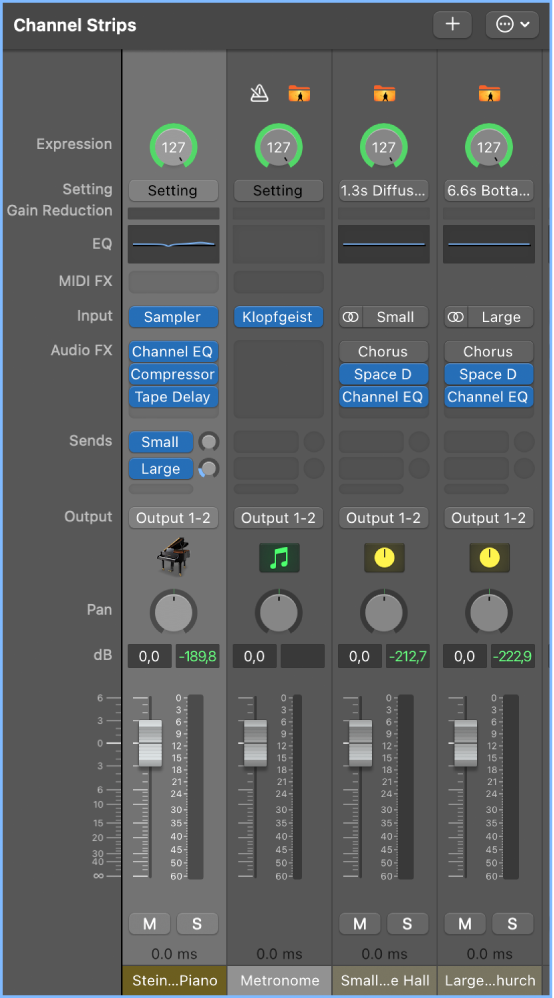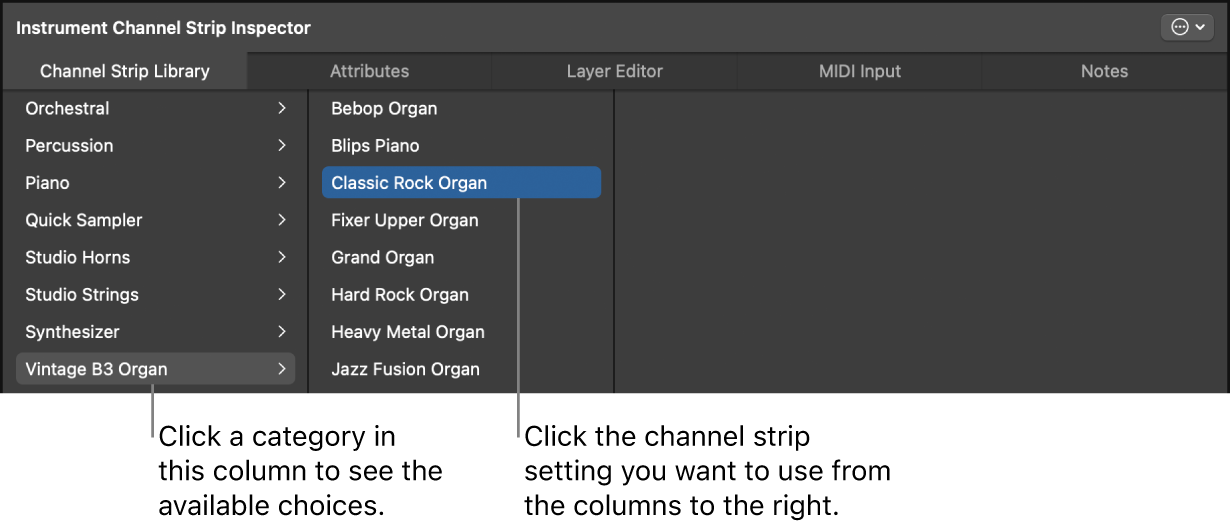MainStage User Guide
- Welcome
-
- Overview of Edit mode
-
- Select patches and sets in the Patch List
- Copy, paste, and delete patches
- Reorder and move patches in the Patch List
- Add and rename patches
- Create a patch from several patches
-
- Overview of the Patch Settings Inspector
- Select patch settings in the Patch Library
- Set the time signature for patches
- Change the tempo when you select a patch
- Set program change and bank numbers
- Defer patch changes
- Instantly silence the previous patch
- Change patch icons
- Transpose the pitch of incoming notes for a patch
- Change the tuning for a patch
- Add text notes to a patch
-
- Overview of channel strips
- Add a channel strip
- Change a channel strip setting
- Configure channel strip components
- Show signal flow channel strips
- Hide the metronome channel strip
- Create an alias of a channel strip
- Add a patch bus
- Set channel strip pan or balance positions
- Set channel strip volume levels
- Mute and solo channel strips
- Use multiple instrument outputs
- Use external MIDI instruments
- Reorganize channel strips
- Delete channel strips
-
- Overview of the Channel Strip Inspector
- Choose channel strip settings
- Rename channel strips
- Change channel strip colors
- Change channel strip icons
- Use feedback protection with channel strips
- Set keyboard input for a software instrument channel strip
- Transpose individual software instruments
- Filter MIDI messages
- Scale channel strip velocity
- Set channel strips to ignore Hermode tuning
- Override concert- and set-level key ranges
- Add text notes to a channel strip in the Channel Strip Inspector
- Route audio via send effects
-
- Screen Control Inspector overview
- Replace parameter labels
- Choose custom colors for screen controls
- Change background or grouped screen control appearance
- Set screen controls to show the hardware value
- Set parameter change behavior for screen controls
- Set hardware matching behavior for screen controls
- Reset and compare changes to a patch
- Override concert- and set-level mappings
-
- Overview of mapping screen controls
- Map to channel strip and plug-in parameters
- Map screen controls to actions
- Map a screen control to multiple parameters
- Use screen controls to display PDF document pages
- Edit the saved value for a mapped parameter
- Set drum pads or buttons to use note velocity
- Map screen controls to all channel strips in a patch
- Undo screen control parameter mappings
- Remove screen control mappings
- Work with graphs
- Create controller transforms
- Share patches and sets between concerts
- Record the audio output of a concert
-
- Overview of concerts
- Create a concert
- Open and close concerts
- Save concerts
- How saving affects parameter values
- Clean up concerts
- Consolidate assets in a concert
- Rename the current concert
-
- Overview of the Concert Settings Inspector
- Set MIDI Routing to channel strips
- Transpose incoming note pitch for a concert
- Define the program change message source
- Send unused program changes to channel strips
- Set the time signature for a concert
- Change the tuning for a concert
- Set the pan law for a concert
- Add text notes to a concert
- Control the metronome
- Silence MIDI notes
- Mute audio output
-
- Layout mode overview
-
- Screen control parameter editing overview
- Lift and stamp screen control parameters
- Reset screen control parameters
- Common screen control parameters
- Keyboard screen control parameters
- MIDI activity screen control parameters
- Drum pad screen control parameters
- Waveform screen control parameters
- Selector screen control parameters
- Text screen control parameters
- Background screen control parameters
- How MainStage passes through MIDI messages
- Export and import layouts
- Change the aspect ratio of a layout
-
- Before performing live
- Use Perform mode
- Screen controls in performance
- Tempo changes during performance
- Tips for performing with keyboard controllers
- Tips for performing with guitars and other instruments
- Tune guitars and other instruments with the Tuner
- The Playback plug-in in performance
- Record your performances
- After the performance
- Tips for complex hardware setups
-
- Overview of keyboard shortcuts and command sets
-
- Concerts and layouts keyboard shortcuts
- Patches and sets (Edit mode) keyboard shortcuts
- Editing keyboard shortcuts
- Actions keyboard shortcuts
- Parameter mapping (Edit mode) keyboard shortcuts
- Channel strips (Edit mode) keyboard shortcuts
- Screen controls (Layout mode) keyboard shortcuts
- Perform in Full Screen keyboard shortcuts
- Window and view keyboard shortcuts
- Help and support keyboard shortcuts
-
-
- Use MIDI plug-ins
-
- Arpeggiator overview
- Arpeggiator control parameters
- Note order parameters overview
- Note order variations
- Note order inversions
- Arpeggiator pattern parameters overview
- Use Live mode
- Use Grid mode
- Arpeggiator options parameters
- Arpeggiator keyboard parameters
- Use keyboard parameters
- Assign controllers
- Modifier controls
- Note Repeater controls
- Randomizer controls
-
- Use Scripter
- Use the Script Editor
- Scripter API overview
- MIDI processing functions overview
- HandleMIDI function
- ProcessMIDI function
- GetParameter function
- SetParameter function
- ParameterChanged function
- Reset function
- JavaScript objects overview
- Use the JavaScript Event object
- Use the JavaScript TimingInfo object
- Use the Trace object
- Use the MIDI event beatPos property
- Use the JavaScript MIDI object
- Create Scripter controls
- Transposer controls
-
-
- Alchemy overview
- Alchemy interface overview
- Alchemy Name bar
- Alchemy file locations
-
- Alchemy source overview
- Source master controls
- Import browser
- Source subpage controls
- Source filter controls
- Source filter use tips
- Source elements overview
- Additive element controls
- Additive element effects
- Spectral element controls
- Spectral element effects
- Pitch correction controls
- Formant filter controls
- Granular element controls
- Sampler element controls
- VA element controls
- Wide unison mode
- Source modulations
- Morph controls
- Alchemy master voice section
- Alchemy Extended parameters
-
- Playback plug-in overview
- Add a Playback plug-in
- Playback interface
- Use the Playback waveform display
- Playback transport and function buttons
- Playback information display
- Playback Sync, Snap To, and Play From parameters
- Use the Playback group functions
- Use the Playback Action menu and File field
- Use markers with the Playback plug-in
-
- Sample Alchemy overview
- Interface overview
- Add source material
- Edit mode
- Play modes
- Source overview
- Synthesis modes
- Granular controls
- Additive effects
- Additive effect controls
- Spectral effect
- Spectral effect controls
- Filter module
- Lowpass, bandpass, and highpass filters
- Comb PM filter
- Downsampler filter
- FM filter
- Envelope generators
- Mod Matrix
- Modulation routing
- Motion mode
- Trim mode
- More menu
-
- Sculpture overview
- Sculpture interface
- Global parameters
- Amplitude envelope parameters
- Use the Waveshaper
- Filter parameters
- Output parameters
- Define MIDI controllers
- Extended parameters
-
- Studio Piano
- Copyright

Get started with channel strips in MainStage
Channel strips are the building blocks of your patches. You can add channel strips to a patch to create layered sounds and keyboard splits. When you add a channel strip to a patch, you choose the type of channel strip, the output, and other settings. You can mix both types in a single patch.
You can adjust channel strip output using the Volume fader, adjust pan position using the Pan knob, and mute or solo the channel strip using the Mute and Solo buttons. For audio channel strips, you can switch between mono and stereo format using the Format button. For software instrument channel strips, you can choose a different instrument from the Input pop-up menu. You can choose new channel strip settings, add and edit effects, add sends to busses, and change the output using the controls on the channel strip.
You can also define the key range for a channel strip, create transform and velocity graphs, and filter various MIDI messages to a channel strip in the Channel Strip Inspector. For more information about using channel strips in MainStage, see Overview of channel strips in MainStage.
You can quickly change the instrument, effects, and other parameters for a channel strip by selecting a new setting from the Channel Strip Library. The browser shows available settings for the currently selected channel strip.
Add a channel strip to a patch
Make sure the patch is selected in the MainStage Patch List.
Click the Add Channel Strip button (+) in the upper-right corner of the Channel Strips area.
Note: You can also use key commands to add channel strips. See Key Commands Overview for more information.
In the New Channel Strip dialog, select the type of channel strip you want to create.
Choose the audio output for the channel strip from the Output pop-up menu.
For audio channel strips, choose mono or stereo format from the Format pop-up menu and choose the audio input from the Input pop-up menu. For external instrument channel strips, also choose the MIDI input, MIDI output, and MIDI channel from their respective pop-up menus.
Important: Audio channel strips can produce feedback, particularly if you are using a microphone for audio input. When you add an audio channel strip, the volume of the channel strip is set to -∞dB. Gradually raise the volume fader on the channel strip until you hear sound on the channel. You can also turn on Feedback Protection in MainStage > Settings > Audio.
Optionally, you can add multiple channel strips to a patch by entering a number in the Number field. You can add up to the maximum number for a channel strip type.
Click Create.
A new channel strip appears in the Channel Strips area, highlighted to indicate that it is selected. The Channel Strip Inspector appears below the workspace, showing different parameters for the new channel strip.
For audio and external instrument channel strips, gradually raise the volume fader until you hear sound on the channel.

Select a new channel strip setting
In MainStage, make sure that the channel strip you want to change is selected (highlighted).
In the Channel Strip Inspector, click the Channel Strip Library tab.
In the Channel Strip Library, channel strip settings appear as a series of folders with different instrument and usage categories. If you have GarageBand or have one or more Jam Pack collections installed on your computer, those settings appear below the built-in settings.
Click a category from the column on the left, then click subcategories from the columns on the right until you see the settings you want.

You can also search for channel strip settings by name and perform other functions using the Channel Strip Library. For more information about the Channel Strip Inspector, see Choose channel strip settings in MainStage.